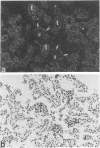Abstract
The expression of the complement protein C3 in extrahepatic tissues is highly regulated during the course of inflammation. Hence, systemic acute phase stimuli such as bacterial lipopolysaccharide (LPS) and autoimmune nephritis in aged 'lupus mice' (MRL-lpr/lpr and NZB x NZW F1) both lead to increased C3 mRNA expression in whole kidney. In situ hybridization was used to determine the intrarenal cell type(s) capable of constitutive and regulated C3 mRNA expression. Normal mice injected with Escherichia coli LPS show a marked increase in whole kidney C3 mRNA over control (saline-injected) animals. The renal C3 mRNA in LPS-stimulated mice was found in cortical tubular epithelium. By contrast, in aged (18 week) MRL-lpr/lpr mice, which develop lupus nephritis, the increased intrarenal C3 messenger RNA was localized to perivascular inflammatory cells surrounding medium-sized arteries. Similar perivascular infiltrates were seen in the lungs of the MRL-lpr/lpr mice, and focal inflammatory cell infiltrates were also found in the myocardium. Leucocytes in these infiltrates accounted for the increased C3 expression in these tissues. These findings suggest cell as well as tissue specificity of the response to inflammatory stimuli in the local extrahepatic production of the third component of complement.
Full text
PDF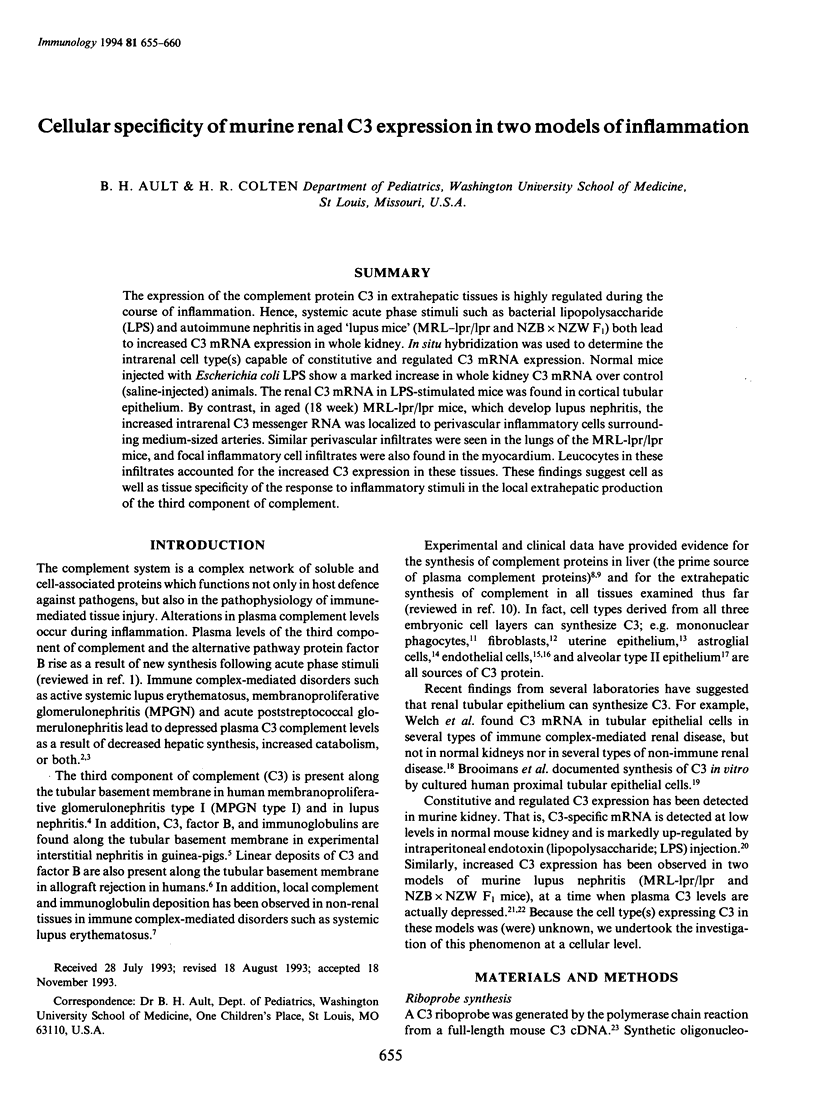
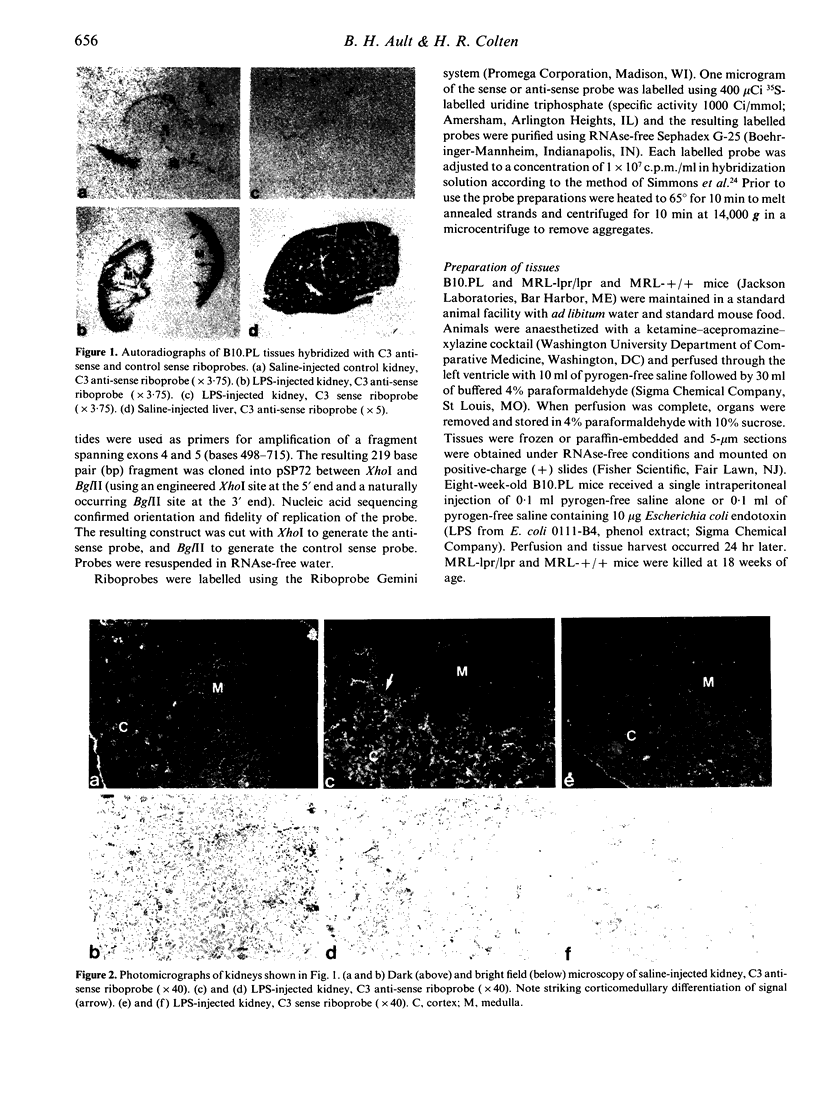
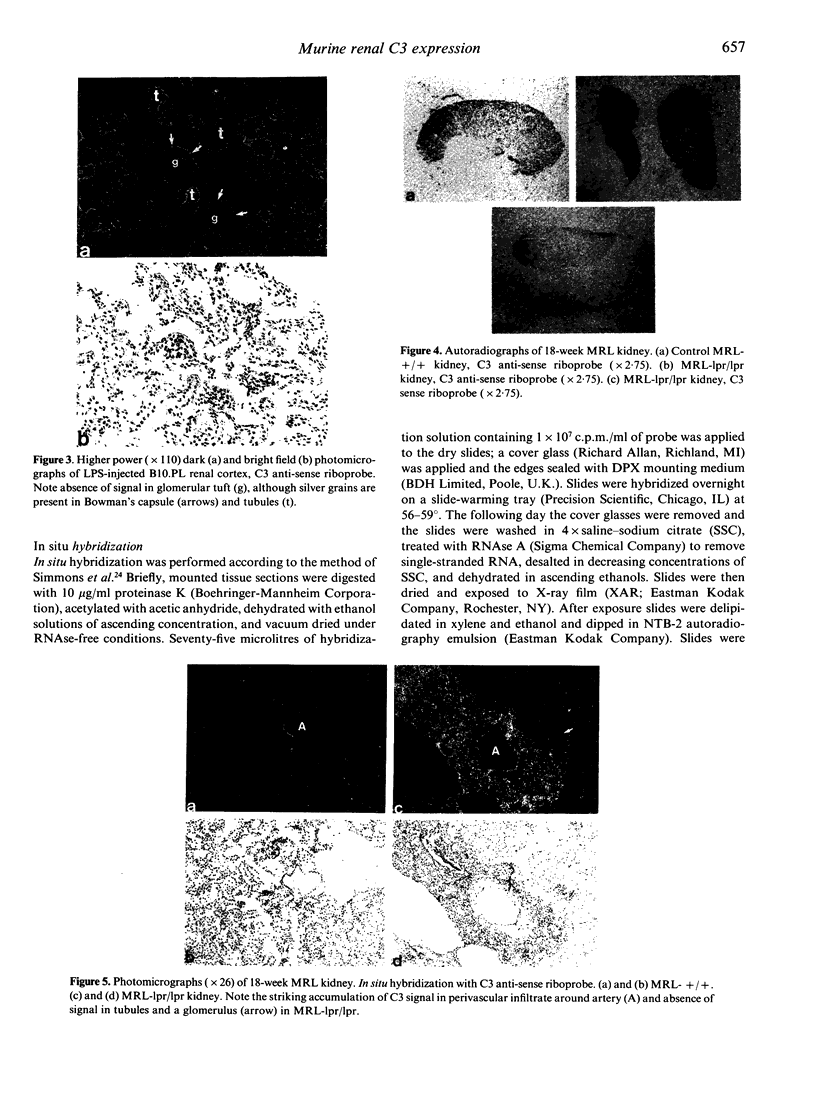
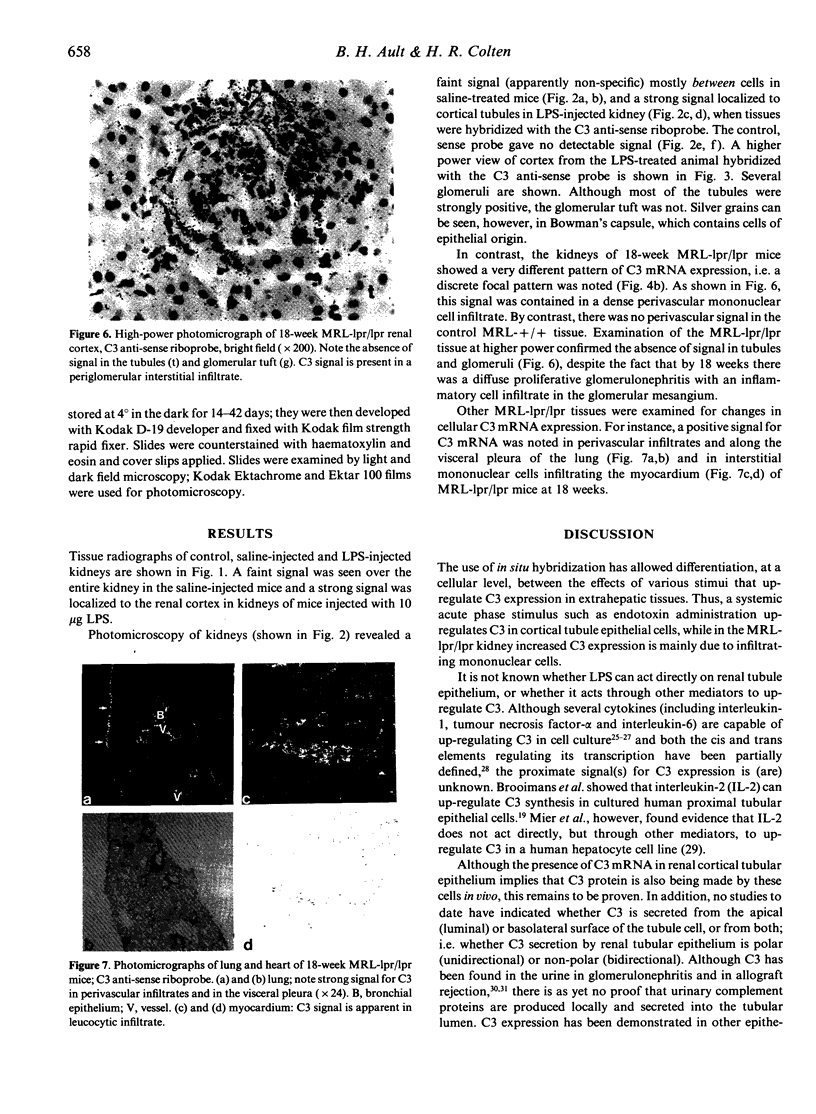
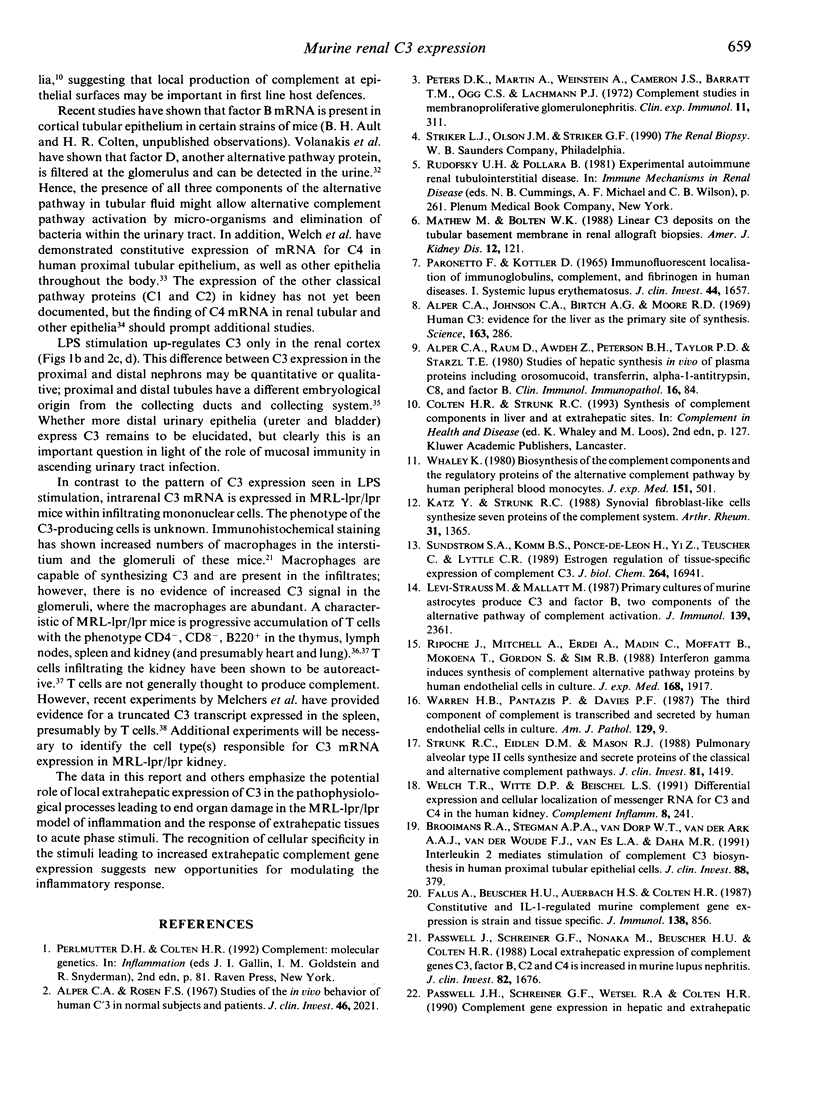
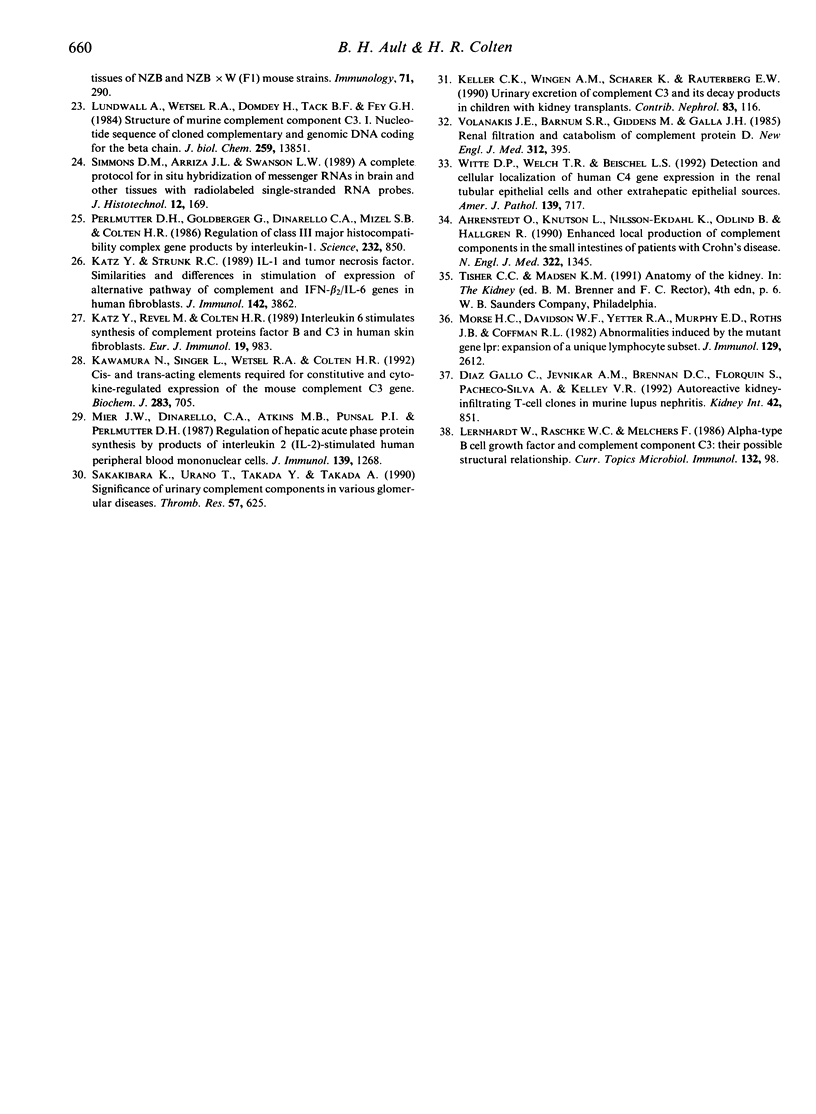
Images in this article
Selected References
These references are in PubMed. This may not be the complete list of references from this article.
- Ahrenstedt O., Knutson L., Nilsson B., Nilsson-Ekdahl K., Odlind B., Hällgren R. Enhanced local production of complement components in the small intestines of patients with Crohn's disease. N Engl J Med. 1990 May 10;322(19):1345–1349. doi: 10.1056/NEJM199005103221903. [DOI] [PubMed] [Google Scholar]
- Alper C. A., Johnson A. M., Birtch A. G., Moore F. D. Human C'3: evidence for the liver as the primary site of synthesis. Science. 1969 Jan 17;163(3864):286–288. doi: 10.1126/science.163.3864.286. [DOI] [PubMed] [Google Scholar]
- Alper C. A., Raum D., Awdeh Z. L., Petersen B. H., Taylor P. D., Starzl T. E. Studies of hepatic synthesis in vivo of plasma proteins, including orosomucoid, transferrin, alpha 1-antitrypsin, C8, and factor B. Clin Immunol Immunopathol. 1980 May;16(1):84–89. doi: 10.1016/0090-1229(80)90169-5. [DOI] [PubMed] [Google Scholar]
- Alper C. A., Rosen F. S. Alper CA, Rosen FS: Studies of the in vivo behavior of human C'3 in normal subjects and patients. J Clin Invest. 1967 Dec;46(12):2021–2034. doi: 10.1172/JCI105691. [DOI] [PMC free article] [PubMed] [Google Scholar]
- Brooimans R. A., Stegmann A. P., van Dorp W. T., van der Ark A. A., van der Woude F. J., van Es L. A., Daha M. R. Interleukin 2 mediates stimulation of complement C3 biosynthesis in human proximal tubular epithelial cells. J Clin Invest. 1991 Aug;88(2):379–384. doi: 10.1172/JCI115314. [DOI] [PMC free article] [PubMed] [Google Scholar]
- Díaz Gallo C., Jevnikar A. M., Brennan D. C., Florquin S., Pacheco-Silva A., Kelley V. R. Autoreactive kidney-infiltrating T-cell clones in murine lupus nephritis. Kidney Int. 1992 Oct;42(4):851–859. doi: 10.1038/ki.1992.360. [DOI] [PubMed] [Google Scholar]
- Falus A., Beuscher H. U., Auerbach H. S., Colten H. R. Constitutive and IL 1-regulated murine complement gene expression is strain and tissue specific. J Immunol. 1987 Feb 1;138(3):856–860. [PubMed] [Google Scholar]
- Katz Y., Revel M., Strunk R. C. Interleukin 6 stimulates synthesis of complement proteins factor B and C3 in human skin fibroblasts. Eur J Immunol. 1989 Jun;19(6):983–988. doi: 10.1002/eji.1830190605. [DOI] [PubMed] [Google Scholar]
- Katz Y., Strunk R. C. IL-1 and tumor necrosis factor. Similarities and differences in stimulation of expression of alternative pathway of complement and IFN-beta 2/IL-6 genes in human fibroblasts. J Immunol. 1989 Jun 1;142(11):3862–3867. [PubMed] [Google Scholar]
- Katz Y., Strunk R. C. Synovial fibroblast-like cells synthesize seven proteins of the complement system. Arthritis Rheum. 1988 Nov;31(11):1365–1370. doi: 10.1002/art.1780311104. [DOI] [PubMed] [Google Scholar]
- Kawamura N., Singer L., Wetsel R. A., Colten H. R. Cis- and trans-acting elements required for constitutive and cytokine-regulated expression of the mouse complement C3 gene. Biochem J. 1992 May 1;283(Pt 3):705–712. doi: 10.1042/bj2830705. [DOI] [PMC free article] [PubMed] [Google Scholar]
- Keller C. K., Wingen A. M., Schärer K., Rauterberg E. W. Urinary excretion of complement C3 and its decay products in children with kidney transplants. Contrib Nephrol. 1990;83:116–119. doi: 10.1159/000418785. [DOI] [PubMed] [Google Scholar]
- Lernhardt W., Raschke W. C., Melchers F. Alpha-type B cell growth factor and complement component C3: their possible structural relationship. Curr Top Microbiol Immunol. 1986;132:98–104. doi: 10.1007/978-3-642-71562-4_13. [DOI] [PubMed] [Google Scholar]
- Lundwall A., Wetsel R. A., Domdey H., Tack B. F., Fey G. H. Structure of murine complement component C3. I. Nucleotide sequence of cloned complementary and genomic DNA coding for the beta chain. J Biol Chem. 1984 Nov 25;259(22):13851–13856. [PubMed] [Google Scholar]
- Lévi-Strauss M., Mallat M. Primary cultures of murine astrocytes produce C3 and factor B, two components of the alternative pathway of complement activation. J Immunol. 1987 Oct 1;139(7):2361–2366. [PubMed] [Google Scholar]
- Mathew M., Bolton W. K. Linear C3 deposits on the tubular basement membrane in renal allograft biopsies. Am J Kidney Dis. 1988 Aug;12(2):121–125. doi: 10.1016/s0272-6386(88)80006-4. [DOI] [PubMed] [Google Scholar]
- Mier J. W., Dinarello C. A., Atkins M. B., Punsal P. I., Perlmutter D. H. Regulation of hepatic acute phase protein synthesis by products of interleukin 2 (IL 2)-stimulated human peripheral blood mononuclear cells. J Immunol. 1987 Aug 15;139(4):1268–1272. [PubMed] [Google Scholar]
- Morse H. C., 3rd, Davidson W. F., Yetter R. A., Murphy E. D., Roths J. B., Coffman R. L. Abnormalities induced by the mutant gene Ipr: expansion of a unique lymphocyte subset. J Immunol. 1982 Dec;129(6):2612–2615. [PubMed] [Google Scholar]
- Paronetto F., Koffler D. Immunofluorescent localization of immunoglobulins, complement, and fibrinogen in human diseases. I. Systemic lupus erythematosus. J Clin Invest. 1965 Oct;44(10):1657–1664. doi: 10.1172/JCI105272. [DOI] [PMC free article] [PubMed] [Google Scholar]
- Passwell J. H., Schreiner G. F., Wetsel R. A., Colten H. R. Complement gene expression in hepatic and extrahepatic tissues of NZB and NZB x W (F1) mouse strains. Immunology. 1990 Oct;71(2):290–294. [PMC free article] [PubMed] [Google Scholar]
- Passwell J., Schreiner G. F., Nonaka M., Beuscher H. U., Colten H. R. Local extrahepatic expression of complement genes C3, factor B, C2, and C4 is increased in murine lupus nephritis. J Clin Invest. 1988 Nov;82(5):1676–1684. doi: 10.1172/JCI113780. [DOI] [PMC free article] [PubMed] [Google Scholar]
- Perlmutter D. H., Goldberger G., Dinarello C. A., Mizel S. B., Colten H. R. Regulation of class III major histocompatibility complex gene products by interleukin-1. Science. 1986 May 16;232(4752):850–852. doi: 10.1126/science.3010455. [DOI] [PubMed] [Google Scholar]
- Peters D. K., Martin A., Weinstein A., Cameron J. S., Barratt T. M., Ogg C. S., Lachmann P. J. Complement studies in membrano-proliferative glomerulonephritis. Clin Exp Immunol. 1972 Jul;11(3):311–320. [PMC free article] [PubMed] [Google Scholar]
- Ripoche J., Mitchell J. A., Erdei A., Madin C., Moffatt B., Mokoena T., Gordon S., Sim R. B. Interferon gamma induces synthesis of complement alternative pathway proteins by human endothelial cells in culture. J Exp Med. 1988 Nov 1;168(5):1917–1922. doi: 10.1084/jem.168.5.1917. [DOI] [PMC free article] [PubMed] [Google Scholar]
- Sakakibara K., Urano T., Takada Y., Takada A. Significance of urinary complement components in various glomerular diseases. Thromb Res. 1990 Feb 15;57(4):625–637. doi: 10.1016/0049-3848(90)90080-v. [DOI] [PubMed] [Google Scholar]
- Strunk R. C., Eidlen D. M., Mason R. J. Pulmonary alveolar type II epithelial cells synthesize and secrete proteins of the classical and alternative complement pathways. J Clin Invest. 1988 May;81(5):1419–1426. doi: 10.1172/JCI113472. [DOI] [PMC free article] [PubMed] [Google Scholar]
- Sundstrom S. A., Komm B. S., Ponce-de-Leon H., Yi Z., Teuscher C., Lyttle C. R. Estrogen regulation of tissue-specific expression of complement C3. J Biol Chem. 1989 Oct 5;264(28):16941–16947. [PubMed] [Google Scholar]
- Volanakis J. E., Barnum S. R., Giddens M., Galla J. H. Renal filtration and catabolism of complement protein D. N Engl J Med. 1985 Feb 14;312(7):395–399. doi: 10.1056/NEJM198502143120702. [DOI] [PubMed] [Google Scholar]
- Warren H. B., Pantazis P., Davies P. F. The third component of complement is transcribed and secreted by cultured human endothelial cells. Am J Pathol. 1987 Oct;129(1):9–13. [PMC free article] [PubMed] [Google Scholar]
- Whaley K. Biosynthesis of the complement components and the regulatory proteins of the alternative complement pathway by human peripheral blood monocytes. J Exp Med. 1980 Mar 1;151(3):501–516. doi: 10.1084/jem.151.3.501. [DOI] [PMC free article] [PubMed] [Google Scholar]
- Witte D. P., Welch T. R., Beischel L. S. Detection and cellular localization of human C4 gene expression in the renal tubular epithelial cells and other extrahepatic epithelial sources. Am J Pathol. 1991 Oct;139(4):717–724. [PMC free article] [PubMed] [Google Scholar]





